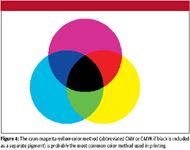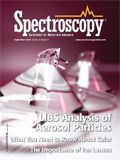Color
Columnist David W. Ball discusses how a scarf featuring the visible emission spectrum of hydrogen inspired his latest column, on color.

My first (and so far, only) wife recently gave me a gift: a black scarf that she had crocheted. The scarf wasn't all black — positioned at appropriate positions were colored yarn so that the scarf mimicked the visible emission spectrum of hydrogen! (OK, so both my wife and I are geeks . . . .) She said that she let each row stand for 1 nmr of wavelength so that the scarf represented the 300-nm range that is commonly used to define the approximate limits of visible light. I now look forward to the cold weather so I can wear it. I wondered what inspiration a Balmer-series scarf might provide me for a column for "The Baseline." Once again, my wife gave me a gift — an idea. Why not a column on color?
Color is the perception of relative different-wavelength light intensities by the human eye — in doing so, the eye is acting like a spectroscope, an analogy pointed out in a previous column (1). Typically, when the word color is used, it is used in exclusive reference to variations in visible light. This is rather anthropocentric, as other animals may see different regions of light. Bees and other insects, for example, have different chromophores in their eyes that are insensitive to red light but are sensitive to ultraviolet light. (Bug zappers take advantage of this physiological difference.)

David W. Bal
A discussion of the history of the discovery of color is best found elsewhere. However, probably the single largest advance in the understanding of color was when Isaac Newton demonstrated in the early 1670s that white light was a combination of all colors of light. This makes color perception an issue of variable absorption (or, equivalently, variable reflection) of different components of white light. Objects do not emit color; rather, they absorb and reflect colors in different amounts, allowing them to be perceived as colored based upon what colors they do and do not absorb.
Spectral Colors
The spectral colors are those colors that can be defined by a single wavelength or frequency or energy of light. Figure 1 shows a printed version of a continuous visible spectrum. As good as Figure 1 may be, it is not a perfect representation because the figure is being reproduced using the four-color printing process, rather than using a different colored ink for every possible color on the continuous spectrum — an impossibility in any case. (More discussion of this is found later.)

Figure 1
Spectral colors are also called monochromatic and are sometimes referred to as pure colors. The colors are commonly separated into six or seven main regions: red, orange, yellow, green, blue, and violet (the familiar ROY G. BV). Some people add indigo as a separate color, making ROY's last name BIV. However, there is still debate as to whether indigo deserves to be a separate color. It should be noted, though, that the identification of these six (or seven) specific colors as "the" colors of the rainbow is completely arbitrary! However, they are so ingrained in our society that they seem to be the "natural" colors.
As mentioned earlier, objects have a color caused by what colors of light are reflected from them. However, objects may not have a spectral color, because more than one wavelength (or more correctly, range of wavelengths) can be reflected simultaneously. Also, the relative amount of light reflected will influence the apparent color of the object. An object that reflects both blue and red may look bright pink or burgundy, depending upon the relative amounts of red and blue light that are reflected. Note that neither "bright pink" nor "burgundy" is in our list of spectral colors. The spectral colors may themselves be complete as a set, but their number of possible combinations is literally infinite.
Representing Colors With Light
In addition to the absorption–reflection process, different colors can be generated another way: as the emission of lights of certain colors. These colors are referred to as additive colors. Different combinations of colored lights of various intensities will yield different perceived colors. Again, we cannot have an infinite number of differently colored lights, each one representing a different spectral color. Instead, we rely upon various standard combinations that can be varied to generate an overall light color of different types.
"Standard" combinations of lights are, technically, anything but: there are an infinite number of base colors that can be used to reproduce all possible colors. Over time, standards have been developed for various reasons (including the availability of phosphors of the right colors), and currently, most colored-light generation uses the combination of red, green, and blue lights to generate colors (the so-called RGB color model; see Figure 2). Those three colors are known as the primary colors for this particular model. Many devices that emit or detect light — televisions of the various forms, digital cameras and projectors, and color scanners — use an RGB color model, arguably the most natural choice because it uses the specific colors the cones in the retina are sensitive to.

Figure 2
An RGB color model is probably most visible if you take a very close look at your television or computer monitor: the entire screen is full of tiny red, green, and blue dots called pixels. The intensity of each pixel color is varied to produce the desired color. Because of different manufacturing processes and materials, however, a color image may look different from one output device to another, leading to some variation in perception of color in many consumer products. Thus, there is no single "RGB" color model; several specific RGB color models have been defined industrially, by Microsoft and Adobe for example. Specifying an exact color also requires that you define which system, or color space, you are using.
The RGB color model might make biological sense, but it is not the only possible model. Any set of colors — usually but not required to be three — that can stimulate the three different cones in the retina can be used to generate colored light.
Generating Color With Pigments
If you want to generate color in print, another tactic is necessary — you have to use colored pigments that, when combined, yield the desired color. Again, you can use either an infinite number of pigments, one for each possible color, or select a standard set of a few colors that can be combined in infinite ratios. Solid objects have a color based upon the wavelengths of light they are reflecting, not producing. Thus, generating color by mixing pigments is known as a subtractive color model. As with additive color models, there are many possibilities, but some standards have been agreed upon for simplicity.
Red, yellow, and blue make up a model called the RYB model that is still used today in art (Figure 3). However, this system has limits — it is not possible to generate bright colors like magenta, since a subtractive color scheme is based upon absorbed light; colors that are produced are invariably darker than the starting pigments.

Figure 3
The most common color model for printed color is the one based upon cyan, magenta, and yellow: the CMY, or CMYK (which includes black; the letter K stands for "key," from the black key line used in printing to align the different colors), color model (Figure 4). Although the combination of cyan, magenta, and yellow does yield black, many printing processes use black pigment in addition to the three primary colors: it saves pigment and money; the combination of three pigments can overload the paper it's printing on; or the combination of the three primary pigments may not turn out a satisfactory black color. These colors, including black, make up the "four color" printing process often spoken of in the publishing industry.

Figure 4
The CMYK color model also has its limitations. Light colors are hard to represent unless an inkjet printer can produce a smaller dot of pigment, so that the (usually) white paper can blend with the smaller dot of pigment. Some color printing processes use lighter inks of the base colors, so that lighter hues can be produced (abbreviated with the lowercase letter for the color(s) used; hence, CcMmYK for six-color printing, and so forth). Gray ink or pigment is also available. Some color printers add additional colors to the fundamental four, including orange and green. Specifications for color inkjet and laser printers should list what colors of ink or toner are used; the wide variety of possible colors explains why it can be so confusing to buy replacement inks or toners for your color printer.
Translating color accurately from one medium to another is a challenge because different display or printing devices have slightly different color models — one computer monitor's "red" may be slightly different than a magazine printer's "red." Lighting also affects the look of the printed color, a fact not lost on marketers and art museum curators.
How well did this publication reproduce colors? Generate yourself a spectrum from a slit of sunlight (you can do it — you're a spectroscopist!) and compare it to Figure 1. The difference will illustrate how difficult it can be to represent color.
David W. Ball is a professor of chemistry at Cleveland State University in Ohio. Many of his "Baseline" columns have been reprinted in book form by SPIE Press as The Basics of Spectroscopy, available through the SPIE Web Bookstore at www.spie.org. His most recent book, Field Guide to Spectroscopy (published in May 2006), is available from SPIE Press. He can be reached at d.ball@csuohio.edu; his website is academic.csuohio.edu/ball.
References
(1) D.W. Ball, Spectroscopy 20(4), 29–30 (2005).

LIBS Illuminates the Hidden Health Risks of Indoor Welding and Soldering
April 23rd 2025A new dual-spectroscopy approach reveals real-time pollution threats in indoor workspaces. Chinese researchers have pioneered the use of laser-induced breakdown spectroscopy (LIBS) and aerosol mass spectrometry to uncover and monitor harmful heavy metal and dust emissions from soldering and welding in real-time. These complementary tools offer a fast, accurate means to evaluate air quality threats in industrial and indoor environments—where people spend most of their time.
NIR Spectroscopy Explored as Sustainable Approach to Detecting Bovine Mastitis
April 23rd 2025A new study published in Applied Food Research demonstrates that near-infrared spectroscopy (NIRS) can effectively detect subclinical bovine mastitis in milk, offering a fast, non-invasive method to guide targeted antibiotic treatment and support sustainable dairy practices.
Smarter Sensors, Cleaner Earth Using AI and IoT for Pollution Monitoring
April 22nd 2025A global research team has detailed how smart sensors, artificial intelligence (AI), machine learning, and Internet of Things (IoT) technologies are transforming the detection and management of environmental pollutants. Their comprehensive review highlights how spectroscopy and sensor networks are now key tools in real-time pollution tracking.